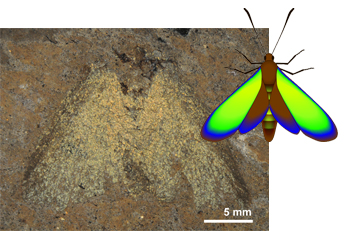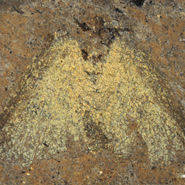Posted 17 November 2011
Ancient fossils reveal moth’s true colours
Scientists have determined the original colours of an ancient moth which lived more than 47 million years ago in Germany.
The scientific methods which led to the discovery could help scientists identify the colours of many other long-extinct creatures including birds, fish, and insects, and shed light on the function and evolution of colour patterns.
The lead author on the research paper published in the online journal PLoS Biology (15 November 2011), Dr Maria McNamara is a member of the UCD School of Geological Sciences at University College Dublin and a postdoctoral researcher at Yale University under an IRCSET-Marie Curie International Mobility Fellowship Award.

The restored colours of a 47-million-year-old moth (fossil, above) may have served to camouflage the insect and warn would-be predators of the creature's toxic taste. Credit: Adapted from M. E. McNamara et al., PLoS Biology, 9 (2011)
Using electron microscopy and other techniques at Yale University, McNamara’s interdisciplinary team examined fossilised scales of daytime moths that lived more than 47 million years ago. The fossils were originally found at the Messel oil shale pit near Frankfurt, Germany, a celebrated source of high-quality fossils.
Evidence from anatomical details preserved in the scales helped establish the structural color of their forewings — a matte, non-iridescent yellow-green. Elsewhere the moth was brown, blue, and green-cyan.
Structural colors are the brightest colors in nature — purer and more intense than chemical pigments. Tissue design generates structural colors by scattering light.
“The ancient day moth’s colors appear to have served defensive purposes,” said Dr McNamara.
“When it was eating and vulnerable to attack, the colors warned off predators; when the moth was at rest in leafy habitats, the colors provided camouflage.”
“The living members of this group of day-flying moths are often brightly colored, and this fossil shows that color evolved for protection in these insects at least 50 million years ago,” said co-author Derek E. G. Briggs, the Yale paleontologist whose lab hosted the moth research.
The international research team included: Heeso Noh and Hui Cao, Department of Applied Physics, Yale University; Patrick J. Orr, UCD School of Geological Sciences, University College Dublin; and Sonja Wedmann of the Senckenberg Forschungsinstitut und Naturmuseum in Germany, which provided the fossil specimens.
The research was supported by a Marie Curie International Mobility Fellowship through University College Dublin and the National Science Foundation.(Produced by UCD University Relations)

